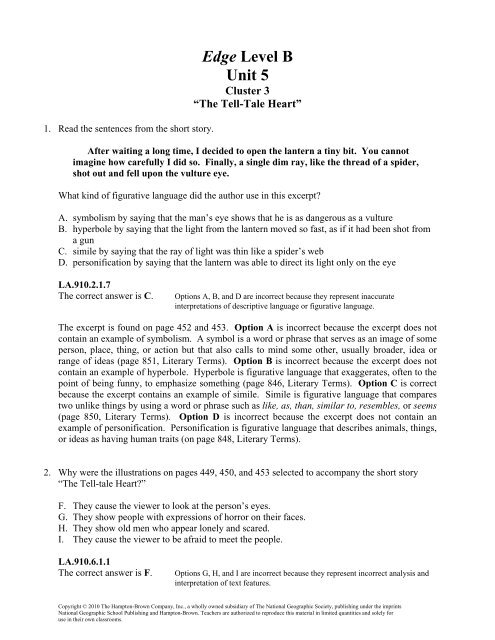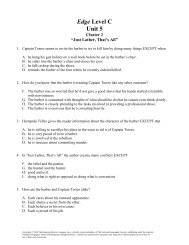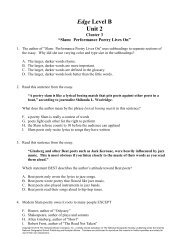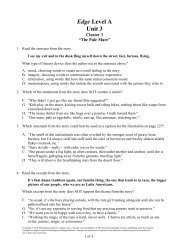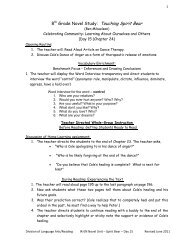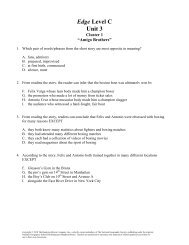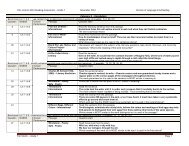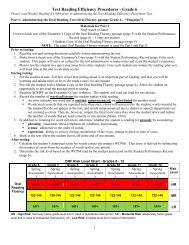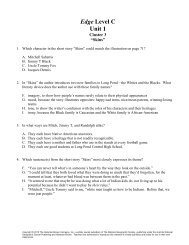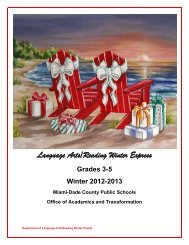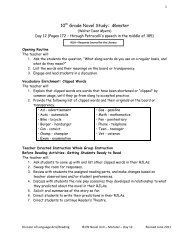Edge Level B Unit 5 - Division of Language Arts/Reading
Edge Level B Unit 5 - Division of Language Arts/Reading
Edge Level B Unit 5 - Division of Language Arts/Reading
Create successful ePaper yourself
Turn your PDF publications into a flip-book with our unique Google optimized e-Paper software.
1. Read the sentences from the short story.<br />
<strong>Edge</strong> <strong>Level</strong> B<br />
<strong>Unit</strong> 5<br />
Cluster 3<br />
“The Tell-Tale Heart”<br />
After waiting a long time, I decided to open the lantern a tiny bit. You cannot<br />
imagine how carefully I did so. Finally, a single dim ray, like the thread <strong>of</strong> a spider,<br />
shot out and fell upon the vulture eye.<br />
What kind <strong>of</strong> figurative language did the author use in this excerpt?<br />
A. symbolism by saying that the man’s eye shows that he is as dangerous as a vulture<br />
B. hyperbole by saying that the light from the lantern moved so fast, as if it had been shot from<br />
a gun<br />
C. simile by saying that the ray <strong>of</strong> light was thin like a spider’s web<br />
D. personification by saying that the lantern was able to direct its light only on the eye<br />
LA.910.2.1.7<br />
The correct answer is C.<br />
Options A, B, and D are incorrect because they represent inaccurate<br />
interpretations <strong>of</strong> descriptive language or figurative language.<br />
The excerpt is found on page 452 and 453. Option A is incorrect because the excerpt does not<br />
contain an example <strong>of</strong> symbolism. A symbol is a word or phrase that serves as an image <strong>of</strong> some<br />
person, place, thing, or action but that also calls to mind some other, usually broader, idea or<br />
range <strong>of</strong> ideas (page 851, Literary Terms). Option B is incorrect because the excerpt does not<br />
contain an example <strong>of</strong> hyperbole. Hyperbole is figurative language that exaggerates, <strong>of</strong>ten to the<br />
point <strong>of</strong> being funny, to emphasize something (page 846, Literary Terms). Option C is correct<br />
because the excerpt contains an example <strong>of</strong> simile. Simile is figurative language that compares<br />
two unlike things by using a word or phrase such as like, as, than, similar to, resembles, or seems<br />
(page 850, Literary Terms). Option D is incorrect because the excerpt does not contain an<br />
example <strong>of</strong> personification. Personification is figurative language that describes animals, things,<br />
or ideas as having human traits (on page 848, Literary Terms).<br />
2. Why were the illustrations on pages 449, 450, and 453 selected to accompany the short story<br />
“The Tell-tale Heart?”<br />
F. They cause the viewer to look at the person’s eyes.<br />
G. They show people with expressions <strong>of</strong> horror on their faces.<br />
H. They show old men who appear lonely and scared.<br />
I. They cause the viewer to be afraid to meet the people.<br />
LA.910.6.1.1<br />
The correct answer is F.<br />
Options G, H, and I are incorrect because they represent incorrect analysis and<br />
interpretation <strong>of</strong> text features.<br />
Copyright © 2010 The Hampton-Brown Company, Inc., a wholly owned subsidiary <strong>of</strong> The National Geographic Society, publishing under the imprints<br />
National Geographic School Publishing and Hampton-Brown. Teachers are authorized to reproduce this material in limited quantities and solely for<br />
use in their own classrooms.
The illustration by Mark Summers on page 449 shows a person’s face with one side completely<br />
in shadow. The eye on the lighted side <strong>of</strong> the face looks like it is from a sculpture because the<br />
eye has no pupil. The illustration on page 450 is titled “Dying” and is by Theodore Géricault. It<br />
shows the face <strong>of</strong> a man; it is gaunt and distorted. The illustration on page 453 is titled “Head<br />
III” by Francis Bacon. It shows a man’s face, and from his forehead up the face has become part<br />
<strong>of</strong> the background. The eyes, especially the left eye, look right at the viewer. Option F is correct<br />
because each <strong>of</strong> the illustrations seem to draw the viewer’s attention to the eyes <strong>of</strong> the<br />
illustrators’ subjects. Option G is incorrect because none <strong>of</strong> the illustrations’ subjects seem to<br />
be horrified, although they may create a feeling <strong>of</strong> horror in those viewing the illustrations.<br />
Option H is incorrect because not all <strong>of</strong> the people in the illustrations are old. The subject in the<br />
illustration on page 449 does not seem old; there are no wrinkles or obvious signs <strong>of</strong> age. The<br />
man shown in the illustration on page 450, although he looks quite sickly, seems not to be too<br />
old because his hair and beard are not white. The man in the illustration on page 453 does<br />
appear old due to his white beard. Option I is incorrect because not all the subjects seem to be<br />
dangerous or scary. The person shown on page 449 looks like a warrior or adventurer due to the<br />
hat/helmet. The man shown on page 450 looks deathly ill, but not scary. The man shown on<br />
page 453, because only part <strong>of</strong> his head is visible and he seems to be disappearing into the<br />
background, could be considered scary.<br />
3. What technique did Edgar Allen Poe use to develop the plot <strong>of</strong> “The Tell-Tale Heart?”<br />
A. foreshadowing<br />
B. cliffhanger<br />
C. flashback<br />
D. dialogue among characters<br />
LA.910.2.1.5<br />
The correct answer is C.<br />
Options A, B, and D are incorrect because they represent inaccurate<br />
interpretations <strong>of</strong> character, point <strong>of</strong> view, plot development, setting, conflict, or<br />
theme.<br />
Option A is incorrect because the plot is not developed through the use <strong>of</strong> foreshadowing.<br />
Foreshadowing is a hint that a writer gives about an event that will happen later in a story (page<br />
845, Literary Terms). Option B is incorrect because the plot is not developed though the use <strong>of</strong><br />
a cliffhanger. Macmillandictionary.com defines cliffhanger as a situation in which it is not clear<br />
what will happen next. The reader learns at the beginning <strong>of</strong> the story on page 450 that the<br />
narrator has committed murder, “In fact, I was never kinder to him than during the whole week<br />
before I killed him.” Option C is correct because the plot is developed through the use <strong>of</strong> a<br />
flashback. Flashback is an interruption in the action <strong>of</strong> a narrative to tell about something that<br />
happened earlier. It is <strong>of</strong>ten used to give the reader background information about a character or<br />
situation (page 844, Literary Terms). “The Tell-Tale Heart” begins with the narrator telling<br />
about how he feels. Then, in a flashback, he moves into telling about his elaborate planning for<br />
an eventual act <strong>of</strong> murder. Option D is incorrect because the plot is not developed through the<br />
use <strong>of</strong> dialogue among characters. Dialogue is what characters say to each other. Writers use<br />
dialogue to develop characters, move the plot forward, and add interest (page 843, Literary<br />
Terms). The characters in this short story are the narrator, the old man, a neighbor, and three<br />
Hampton Brown <strong>Edge</strong> <strong>Level</strong> B, <strong>Unit</strong> 5, Cluster 3 2 <strong>of</strong> 7
policemen. There is no conversation among the characters. The entire short story is told by the<br />
narrator to the reader.<br />
4. Why did the author give this short story the title “The Tell-Tale Heart?”<br />
F. to show how a younger man’s heart turned cold, leading him to cut out the heart <strong>of</strong> an older<br />
man with whom he lived<br />
G. to reveal to the reader that one’s conscience will not let a person get away with doing<br />
something as horrific as murder<br />
H. to entertain the reader with a story about an insane person who thinks he is sane because he<br />
can make a good plan<br />
I. to tell a tale about the life <strong>of</strong> a young man who cared for an older man for many years until<br />
he died <strong>of</strong> old age<br />
LA.910.1.7.2<br />
The correct answer is G.<br />
Options F, H, and I are incorrect because they represent incorrect interpretations<br />
<strong>of</strong> the author’s purpose or perspective.<br />
Telltale is defined by http://dictionary.reference.com as a thing serving to reveal or disclose<br />
something. Option F is incorrect because the younger man’s heart did not turn cold, he lost is<br />
mind. He did not cut out the heart <strong>of</strong> the older man; he dismembered him as the reader learns on<br />
page 454, “I thought about the best way to hide the body. Then I cut it into pieces. I cut <strong>of</strong>f the<br />
head and the arms and the legs.” Option G is correct because the imagined sounds <strong>of</strong> the old<br />
man’s heart still beating beneath the floor boards, louder and louder, are what made the insane<br />
young man tell the policemen what he had done. As the reader learns on pages 456 and 457, “I<br />
could look at their (the policemen) smiles no longer! I felt that I must scream or die! And now,<br />
again, listen! The sound is louder! Louder! …I admit the deed! Tear up the floor boards! It is<br />
the beating <strong>of</strong> his hideous heart!” Option H is incorrect because the narrator is insane and does<br />
think he is sane because he made a plan. However, this is a major detail in the story, but not the<br />
author’s purpose for writing the story. Option I is incorrect because the man did not die <strong>of</strong> old<br />
age; the younger man suffocated him.<br />
5. The narrator in “The Tell-Tale Heart” tells the reader that he is not insane for many reasons<br />
EXCEPT<br />
A. He figured out the best way to hide the body <strong>of</strong> the old man.<br />
B. He felt that he had an exceptional sense <strong>of</strong> hearing.<br />
C. He did things in a clever and well-planned way.<br />
D. He smiled and welcomed the three police <strong>of</strong>ficers.<br />
LA.910.1.7.3<br />
The correct answer is D.<br />
Options A, B, and C are incorrect because they represent plausible but incorrect<br />
distractors based on the text.<br />
Option A is incorrect because the narrator again reminds the reader <strong>of</strong> his sanity at this point in<br />
the story. As the reader learns on page 454, “If you still think I am mad, you will no longer think<br />
so when I tell you what I did next. I thought about the best way to hide the body. Then I cut it<br />
Hampton Brown <strong>Edge</strong> <strong>Level</strong> B, <strong>Unit</strong> 5, Cluster 3 3 <strong>of</strong> 7
into pieces. I cut <strong>of</strong>f the head and the arms and the legs.” Option B is incorrect because he feels<br />
he is able to hear things very clearly. As the reader learns on page 450, “But why will you say<br />
that I am mad? The disease had made my senses sharper…. Above all, my sense <strong>of</strong> hearing was<br />
sharp. I heard all things in the heaven and in the earth. How, then, can you say I am mad?”<br />
Option C is incorrect because the narrator thinks that the planning and execution <strong>of</strong> the murder<br />
shows his sanity, ignoring the fact that committing the murder may not be considered a sane act.<br />
As the reader learns on page 450, “You think I am mad. But a person who is mad knows<br />
nothing. You should have seen me and how wisely I acted. I was cautious, and I planned<br />
ahead.” Option D is correct because as the narrator relates this part <strong>of</strong> the story, he does not<br />
pr<strong>of</strong>ess his sanity. As the reader learns on page 455, “Three men entered the house. They<br />
introduced themselves as police <strong>of</strong>ficers…. I smiled—for what did I have to fear? I greeted the<br />
<strong>of</strong>ficers warmly.<br />
<strong>Edge</strong> <strong>Level</strong> B<br />
<strong>Unit</strong> 5<br />
Cluster 3<br />
“The Raven”<br />
6. Edgar Allan Poe uses alliteration in many lines EXCEPT<br />
F. line 1: “Once upon a midnight dreary, while I pondered, weak and weary,”<br />
G. line 27: “But the silence was unbroken, and the stillness gave no token,”<br />
H. line 3: “While I sat there, nearly napping, suddenly there came a tapping,”<br />
I. line 37: “Open wide I flung the shutter, when, with many a flit and flutter,”<br />
LA.910.2.1.7<br />
The correct answer is G.<br />
Options F, H, and I are incorrect because they examples <strong>of</strong> descriptive language<br />
or figurative language drawn from the text related to the question being tests.<br />
Alliteration is the repetition <strong>of</strong> the same sounds (usually consonants) at the beginning <strong>of</strong> words<br />
that are close together which is seen with the author’s use <strong>of</strong> pl at the beginning <strong>of</strong> plane and<br />
plopped (page 842, Literary Terms). Option F is incorrect because it contains an example <strong>of</strong><br />
alliteration—the repetition <strong>of</strong> wea at the beginning <strong>of</strong> weak and weary. Option G is correct<br />
because it does not contain an example <strong>of</strong> alliteration. Although two words begin with an s they<br />
make different sounds, /s/ and /st/. Option H is incorrect because it contains an example <strong>of</strong><br />
alliteration—the repetition <strong>of</strong> n at the beginning <strong>of</strong> nearly and napping. Option I is incorrect<br />
because it contains an example <strong>of</strong> alliteration—the repetition <strong>of</strong> fl at the beginning <strong>of</strong> flung, flit,<br />
and flutter.<br />
7. Read the lines from the poem.<br />
But the silence was unbroken, and the stillness gave no token,<br />
And the only word there spoken was the whispered word, “Lenore!”<br />
Hampton Brown <strong>Edge</strong> <strong>Level</strong> B, <strong>Unit</strong> 5, Cluster 3 4 <strong>of</strong> 7
Which word is NOT similar in meaning to token as it is used in this line?<br />
A. sound<br />
B. indication<br />
C. clue<br />
D. sign<br />
LA.910.1.6.8<br />
The correct answer is A.<br />
Options B, C, and D are incorrect because they represent incorrect meanings<br />
(synonyms) <strong>of</strong> the word being assessed.<br />
The excerpt is lines 27 and 28. The Web site mw4.m-w.com/dictionary defines token as an<br />
outward sign or expression. Option A is correct because it is not similar in meaning to the<br />
word being assessed. Sound is defined by macmillandictionary.com as something that you can<br />
hear. Option B is incorrect because it is similar in meaning to the assessed word. Indication is<br />
defined by macmillandictionary.com as a sign that something will happen, is true, or exists.<br />
Option C is incorrect because it is similar in meaning to the word being assessed. Clue is<br />
defined by macmillandictionary.com as a piece <strong>of</strong> information that helps explain a situation or<br />
provide a solution to a problem. Option D is incorrect because it is similar in meaning to the<br />
word being assessed. Sign is defined by macmillandictionary.com as a piece <strong>of</strong> evidence that<br />
something is happening or that something exists.<br />
8. Which illustration that accompanies “The Tell-Tale Heart” could also be used with “The<br />
Raven?”<br />
F. the illustration on page 455<br />
G. the illustration on page 453<br />
H. the illustration on page 449<br />
I. the illustration on page 456<br />
LA.910.6.1.1<br />
The correct answer is H.<br />
Options F, G, and I are incorrect because they represent incorrect analysis and<br />
interpretation <strong>of</strong> text features.<br />
Option F is incorrect because it does not agree with the content <strong>of</strong> “The Raven.” As the reader<br />
learns on page 463 in line 68 a chair is referenced in the poem, “Soon I wheeled a cushioned seat<br />
in front <strong>of</strong> bird and bust and door. However, on page 463 in lines 75-77 the reader learns more<br />
about the appearance <strong>of</strong> the chair which does not match the chair pictured in the illustration, “…I<br />
sat divining, with my head at ease reclining / On the cushion’s velvet lining which the lamp-light<br />
shining…” The chair in the illustration does not have a cushion on its back. Option G is<br />
incorrect because it does not agree with the content <strong>of</strong> “The Raven.” Although the reader does<br />
not know the age <strong>of</strong> the man who narrates “The Raven,” the reader does know that there is light<br />
in the bedroom where the poem is set. In the illustration the man is becoming part <strong>of</strong> his dark<br />
background, and this is not what happens in “The Raven.” Option H is correct because it does<br />
agree with the content <strong>of</strong> “The Raven.” This illustration is most likely a statue <strong>of</strong> the Greek<br />
goddess, Athena, known as Pallas in “The Raven.” In the illustration the bird, a raven, in<br />
perched on her head as the reader learns on page 461, lines 38 and 41, “In there stepped a noble<br />
Hampton Brown <strong>Edge</strong> <strong>Level</strong> B, <strong>Unit</strong> 5, Cluster 3 5 <strong>of</strong> 7
Raven from the ancient days <strong>of</strong> yore….Perched upon a bust <strong>of</strong> Pallas just above my bedroom<br />
door…” Option I is incorrect because it does not agree with the content <strong>of</strong> “The Raven.” It<br />
shows a person who is suffering greatly in agony. Although the narrator in “The Raven” is<br />
mourning for Lenore, Poe does not tell the reader that he is suffering to the degree shown in the<br />
illustration.<br />
9. Read the stanza from the poem.<br />
So I sat engaged in guessing, but without a word expressing<br />
To the bird whose fiery eyes now burned into my spirit’s core;<br />
This and more I sat divining, with my head at ease reclining<br />
On the cushion’s velvet lining which the lamp-light shined all over,<br />
But whose velvet violet lining with the lamp-light shining o’er,<br />
She shall touch, ah, nevermore!<br />
What form <strong>of</strong> figurative language does Poe use in these lines?<br />
A. symbolism by comparing his love to a cushion<br />
B. pun by using divining and guessing to mean the same thing<br />
C. personification by portraying a bird as someone with which to have a conversation<br />
D. metaphor by comparing the gaze <strong>of</strong> the Raven to a fire<br />
LA.910.2.1.7<br />
The correct answer is D.<br />
Options A, B, and C are incorrect because they represent inaccurate<br />
interpretations <strong>of</strong> descriptive language or figurative language.<br />
This stanza is found on page 463 and includes lines 73-78. Option A is incorrect because the<br />
excerpt does not contain an example <strong>of</strong> symbolism. A symbol is a word or phrase that serves as<br />
an image <strong>of</strong> some person, place, thing, or action but that also calls to mind some other, usually<br />
broader, idea or range <strong>of</strong> ideas (page 851, Literary Terms). Option B is incorrect because the<br />
excerpt does not contain an example <strong>of</strong> a pun. A pun is an expression, used for emphasis or<br />
humor, in which two distinct meanings are suggested by one word or by two similar-sounding<br />
words (page 849, Literary Terms). Option C is incorrect because the excerpt does not contain<br />
an example <strong>of</strong> personification. Personification is figurative language that describes animals,<br />
things, or ideas as having human traits (on page 848, Literary Terms). Option D is correct<br />
because the excerpt contains an example metaphor. Metaphor is a type <strong>of</strong> figurative language<br />
that compares two unlike things by saying that one thing is the other thing (page 847, Literary<br />
Terms).<br />
10. The short story “The Tell-Tale Heart” and the poem “The Raven” are similar in many ways<br />
EXCEPT<br />
F. The narrators both show signs <strong>of</strong> insanity.<br />
G. Both works focus on death.<br />
H. Sound plays a pivotal role in each work.<br />
I. The narrators are both mourning the death <strong>of</strong> someone dear to them.<br />
Hampton Brown <strong>Edge</strong> <strong>Level</strong> B, <strong>Unit</strong> 5, Cluster 3 6 <strong>of</strong> 7
LA.910.1.7.7<br />
The correct answer is I.<br />
Options F, G, and H are incorrect because they represent correct comparisons.<br />
Option F is incorrect because neither narrator behaves in a sane manner. The narrator in “The<br />
Tell-Tale Heart” spends a great deal <strong>of</strong> time trying to convince the reader that he is sane while he<br />
behaves in an abnormal way. The narrator in “The Raven” tries to have a conversation with a<br />
large bird who answers every question with the same word, “Nevermore.” Option G is incorrect<br />
because both works do focus on death. “The Tell-Tale Heart” is about the murder <strong>of</strong> an old man<br />
and the thoughts and actions <strong>of</strong> his murderer; “The Raven” is built around the death <strong>of</strong> Lenore<br />
and the mourning <strong>of</strong> the narrator for her. Option H is incorrect because sound is important to<br />
both works. In “The Tell-Tale Heart” the narrator thinks the sound <strong>of</strong> the dead man’s beating<br />
heart must be heard by the police <strong>of</strong>ficers and so he confesses to the murder. In “The Raven” the<br />
narrator hears a tapping at his door, but no one is there. The tapping is heard again at the<br />
window, and, when it is opened, the Raven enters the bedroom. Option I is correct because both<br />
narrators are affected by the death <strong>of</strong> someone near to them; however, only the narrator <strong>of</strong> “The<br />
Raven” is in mourning. As the reader learns on page 455 the narrator is almost happy, “I<br />
smiled—for what did I have to fear? I greeted the <strong>of</strong>ficers warmly…The <strong>of</strong>ficers believed me. I<br />
was at ease. They sat there for a while, chatting about everyday things.” However, in “The<br />
Raven” the narrator is in mourning. As the reader learns on page 459, lines 9-11, “…I had tried<br />
but failed to borrow / Help from books to cease my sorrow—sorrow for the lost Lenore…”<br />
Hampton Brown <strong>Edge</strong> <strong>Level</strong> B, <strong>Unit</strong> 5, Cluster 3 7 <strong>of</strong> 7


